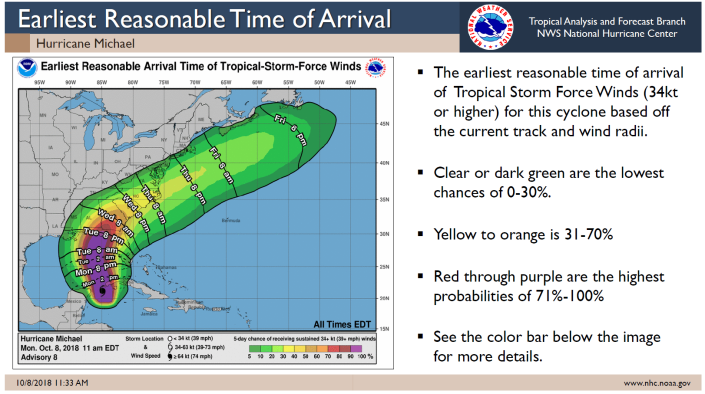Marine
National Hurricane Center Decision Support Services for the United States Coast Guard

Semper Paratus (Always Ready): A Shared Mission of Watching Over a Vast Blue Ocean
The National Hurricane Center (NHC) has the responsibility for issuing weather forecasts and warnings for a wide expanse of the Atlantic and eastern North Pacific Oceans. Within NHC, the Hurricane Specialist Unit (HSU) issues forecasts for tropical storms and hurricanes in these regions, issues associated U. S. watches and warnings, and provides guidance for the issuance of watches and warnings for international land areas. NHC’s Tropical Analysis and Forecast Branch (TAFB) makes forecasts of wind speeds and wave heights and issues wind warnings year-round for the eastern North Pacific Ocean north of the equator to 30°N, and for the Atlantic Ocean north of the equator to 31°N and west of 35°W (including the Gulf of Mexico and Caribbean Sea). These wind warnings include tropical storms and hurricanes as well as winter storms, tradewind gales, and severe gap-wind events (for example, the “Tehuantepecers” south of Mexico).
The United States Coast Guard (USCG) has areas of responsibility (AORs) that extend well beyond those of NHC, with potential weather hazards affecting the fleet and their missions over the ocean, inland U.S. waterways, and flood-prone U.S. land areas. Although the USCG is responsible for search and rescue missions that may occur due to weather hazards, they are also vulnerable to severe weather and must also protect their own fleet and crews from these hazards.

One of the USCG’s oldest missions and highest priorities is to render aid to save lives and property in the maritime environment. To meet these goals, the United States’ area of search-and-rescue responsibility is divided into internationally recognized inland and maritime regions. There are five Atlantic USCG Search and Rescue Regions (SRRs) (Boston, Norfolk, Miami, New Orleans, and San Juan) and two Pacific USCG SRRs (Alameda and Honolulu) that overlap with NHC’s hurricane and marine areas of responsibility. The other eastern Pacific regions north of the Alameda SRR do not typically, if ever, experience hurricane activity. The multi-million square mile area of the agencies’ overlap allows NHC to provide weather hazard Decision Support Services (DSS) for the USCG.
Building Partnerships with the Districts
The National Weather Service (NWS) signed a Memorandum of Agreement (MOA) with the USCG to provide them with weather support. Over the past couple of years, staff at NHC have had numerous discussions with several of the USCG districts in order to build stronger partnerships. These discussions, primarily involving how NHC can better serve the USCG, established criteria for requiring TAFB to provide weather briefings to key decision makers within the USCG. When criteria are met, TAFB provides the relevant USCG District with once- or twice-a-day briefing packages detailing the weather impacts on their area of responsibility. This information provides the USCG districts with the details necessary to make efficient and effective decisions about potential mobilization of their fleet.

2018 Hurricane Season Briefing Support
During the 2018 hurricane season, TAFB provided 30 briefings to USCG Districts 5 (Norfolk), 7 (Miami), 8 (New Orleans), and 11 (Alameda) for the several tropical storms and hurricanes that affected them. These interactions helped to build the relationships between NHC and the USCG districts and aided the districts in making decisions regarding fleet mobilization, conducting search and rescue missions, and preparation for USCG’s land-based assets and personnel. Some of these briefings occurred during rapidly evolving high impact scenarios, including Hurricane Michael. Michael was forecast to become a hurricane within 72 hours of developing into a tropical depression and was forecast to make landfall within 96 hours of its formation. Ultimately, Michael rapidly intensified into a category 5 hurricane only 3½ days after formation, before making landfall on the Florida Panhandle. Hurricane Michael’s track across the east-central Gulf of Mexico straddled the border of USCG Districts 7 (Miami) and 8 (New Orleans), leading to both Districts taking action in advance of the hurricane.
Support for District 5 (Norfolk)
The NWS’s Ocean Prediction Center, the NHC (through TAFB), and the NWS National Operations Center have worked together to provide weekly high-level coordination briefings to USCG District 5 on upcoming hazards focused on the Atlantic Ocean north of 31°N over the following seven days. Each Monday (except Tuesday if Monday is a holiday) by noon Eastern Time, the NWS provides a briefing that covers the mid-Atlantic region from New Jersey through North Carolina. Typically, the briefing covers the area to roughly 65°W, though the exact area covered can vary based on the week’s expected weather hazards. The USCG, in turn, has been sharing the information with mariners, port partners, and industry groups for situational awareness and critical decision-making.
Future Support
NHC’s TAFB is ready to provide decision support services to the USCG Districts for the 2019 hurricane season. Plans are being developed to continue this type of support for many years to come.

